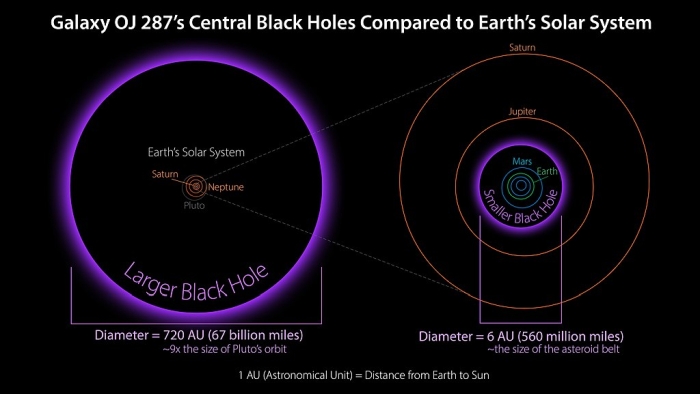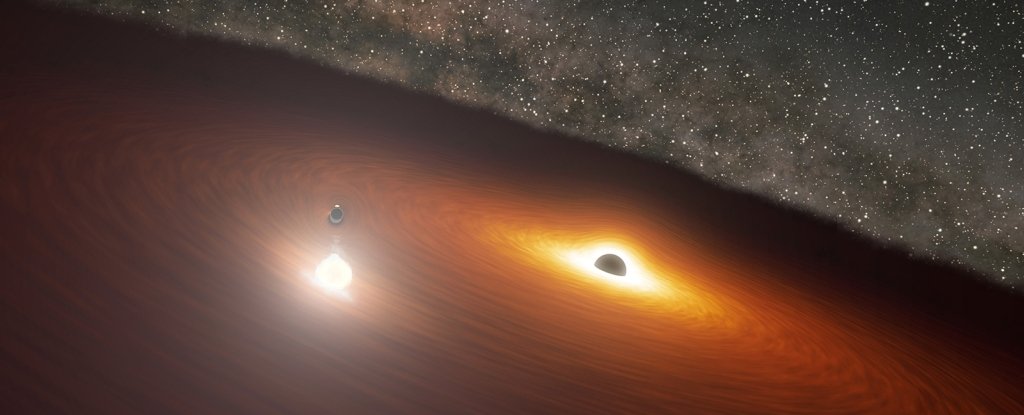Products You May Like
In the depths of space 3.5 billion light-years away, two supermassive black holes are locked in one of the most extreme orbital dances in the Universe. Their riotous, somewhat erratically flaring death spiral has been documented for decades.
With new observations, astronomers have now characterised the way they whirl about each other in the centre of a galaxy called OJ 287. In turn, that characterisation has helped to refine our understanding of whether or not black holes are ‘hairy’, a conundrum that has puzzled cosmologists for decades.
OJ 287 is no ordinary galaxy. It’s a blazar, with a highly variable active galactic nucleus and a relativistic jet beaming at Earth. For over a century, it’s been documented spitting out dazzling flares of radiation at semi-regular intervals.
At its core, OJ 287 is even more intense than most galactic nuclei. It has not one, but two supermassive black holes, and they are chonkers.
The smaller of the two would power a very respectable galactic nucleus in its own right, coming in at 150 million times the mass of the Sun. Our own Milky Way’s supermassive black hole is 4 million solar masses.
The larger of the two is one of the most massive black holes we’ve ever seen. It tips the cosmic scales at 18 billion solar masses.
 (NASA/JPL-Caltech/R. Hurt/IPAC)
(NASA/JPL-Caltech/R. Hurt/IPAC)
This larger black hole is surrounded by a huge accretion disc of dust and gas that whirls around it like water circling a drain, constantly falling into the object. While this creates radiation, it’s not responsible on its own for the giant flares.
The two black holes, you see, are on a 12-year orbit, but the smaller of the two is not oriented with the plane of the accretion disc. It’s on a highly tilted, highly elliptical, precessing orbit. This means that, twice every orbit (12 years), the smaller black hole smashes through the accretion disc, kicking up a gargantuan flare.
Because its orbit is so irregular, the timing of these flares is somewhat different every orbit – the two flares could occur a decade apart, or a year.
However, because observation data has been collected since the late 19th century, astronomers have been able to model this orbit, and have accurately predicted the most recent two flares. One of them occurred in December 2015, and it was predicted within three weeks.
But then in February 2016, something amazing happened. A global scientific collaboration announced they had detected gravitational waves from a collision between two black holes. This confirmed a prediction made by Einstein’s theory of general relativity a century earlier, that the movements of massive objects lose energy in the form of waves rippling out into the Universe.
For most objects, these waves are insignificant. But orbiting supermassive black holes should produce ripples that are so strong, we can spot the influence of those waves in their orbits and the timing of the flares.
Observing and studying gravitational waves allowed scientists to characterise their magnitude and impact; in 2018, this aspect was added into the model for OJ 287.
The second flare, nicknamed the Eddington flare - after the English astronomer Sir Arthur Eddington – occurred on 31 July 2019. And it was predicted to the day.
Calculations also included factors that could help test whether black holes could be described as ‘hairy’. First suggested in the 1960s, the ‘no-hair theorem’ assumes black holes can only be characterised by mass, electric charge, and spin. This would make them perfectly symmetrical, without any other properties or ‘hair’ poking from their surface.
Black holes are pretty hard to probe, so whether or not they have any other properties has remained an open question. But one way to test for hair is to model black holes with and without it, and see which model fits the observation data.
In the case of OJ 287, the no-hair model further refined the prediction timeframe down to just four hours. This suggests that, if there is hair, for now it’s beyond our abilities to detect.
“Observational evidence for the flare arrival within 4 hours of the actual prediction supports the prominent role of including 2PN-accurate GW emission effects while tracking the orbit of the secondary BH. More importantly, our Spitzer observations constrain the celebrated no-hair theorem,” the researchers wrote in their paper.
“These observations are setting the stage for observational campaigns that employ the unprecedented high-resolution imaging capabilities of the Event Horizon Telescope, in combination with the Global Millimeter VLBI Array and the space VLBI mission RadioAstron, to spatially resolve the BBH system in OJ 287.”
The research has been published in The Astrophysical Journal Letters.
